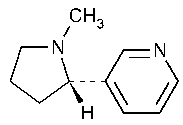Nicotine
»Nicotine contains not less than 99.0percent and not more than 101.0percent of C10H14N2,calculated on the anhydrous basis.
Packaging and storage—
Store under nitrogen in well-closed containers below 25 ,protected from light and moisture.
,protected from light and moisture.
Identification,
Ultraviolet Absorption á197Uñ—
Solutions—
Prepare a solution of Nicotine in water having a concentration of about 1mg per mL.Transfer 1.0mLof this solution to a 50-mLvolumetric flask,dilute with 0.1Nhydrochloric acid to volume,and mix to obtain the test solution.Transfer an amount of USP Nicotine Bitartrate Dihydrate RS,equivalent to about 50mg of nicotine,to a 25-mLglass-stoppered tube.Add 5mLof 6Nammonium hydroxide,2mLof 1Nsodium hydroxide,and 20mLof n-hexane.Shake for 5minutes,allow the phases to separate,transfer the upper n-hexane layer to a vial,and evaporate with a stream of nitrogen gas.[NOTE—Avoid excessive drying to prevent loss of nicotine.]Dissolve the residue of the nicotine so obtained in water to obtain a solution having a concentration of about 1mg per mL.Dilute 1.0mLof this solution with 0.1Nhydrochloric acid to 50.0mL,and mix to obtain the Standard solution.
Specific rotation á781Sñ:
between -130 and -143
and -143 .
.
Test solution:
20mg per mL,in alcohol.
Water,Method Iá921ñ:
not more than 0.5%.
Heavy metals,Method IIá231ñ:
not more than 0.002%.
Chromatographic purity—
Test solution—
Dissolve about 0.13g of Nicotine,accurately weighed,in dichloromethane,dilute with dichloromethane to 25.0mL,and mix.
Reference solutions—
Dilute accurately measured volumes of the Test solutionquantitatively,and stepwise if necessary,with dichloromethane to obtain Reference solution Aand Reference solution Bhaving concentrations of about 26µg per mLand 52µg per mL,respectively.
Chromatographic system(see Chromatography á621ñ)—
The gas chromatograph is equipped with a flame-ionization detector maintained at 270 and a 0.53-mm ×30-m fused silica column bonded with a 1.5-µm layer of phase G1.Helium is used as the carrier gas at a flow rate of 20mLper minute.The column temperature is maintained at 50
and a 0.53-mm ×30-m fused silica column bonded with a 1.5-µm layer of phase G1.Helium is used as the carrier gas at a flow rate of 20mLper minute.The column temperature is maintained at 50 for 6seconds,then programmed to rise from 50
for 6seconds,then programmed to rise from 50 to 250
to 250 at 6
at 6 per minute,and finally held isothermally at 250
per minute,and finally held isothermally at 250 for 3minutes.
for 3minutes.
Procedure—
Separately inject equal volumes (about 1µL)of theTest solution,Reference solution A,andReference solution Binto the chromatograph,and allow theTest solutionto elute for not less than 2.5times the retention time of nicotine.Record the chromatograms,and measure all of the peak responses.The sum of the peak responses,excluding that of nicotine,from theTest solutionis not more than that of the nicotine response fromReference solution B(1.0%),and no single peak response is greater than that of the nicotine response fromReference solution A(0.5%).
Assay—
Dissolve about 60mg of Nicotine,accurately weighed,in 40mLof glacial acetic acid,and titrate with 0.1Nperchloric acid VS,determining the endpoint potentiometrically (seeTitrimetry á541ñ).Perform a blank determination,and make any necessary correction.Each mLof 0.1Nperchloric acid is equivalent to 8.11mg of C10H14N2.
Auxiliary Information—
Staff Liaison:Ravi Ravichandran,Ph.D.,Senior Scientist
Expert Committee:(PA3)Pharmaceutical Analysis 3
USP28–NF23Page 1371
Pharmacopeial Forum:Volume No.28(5)Page 1420
Phone Number:1-301-816-8330
